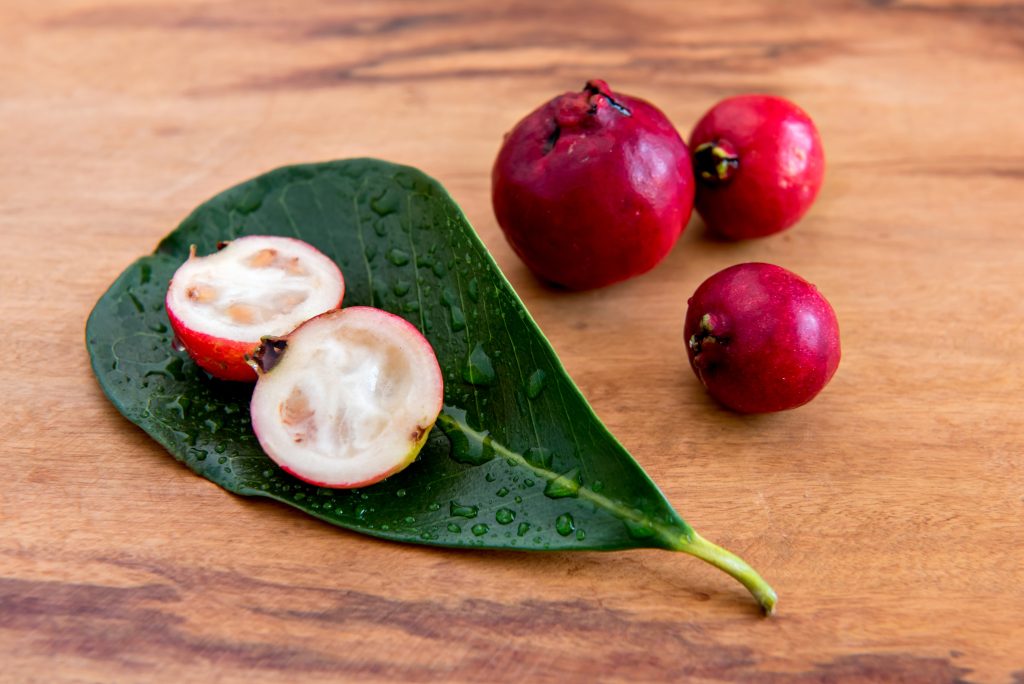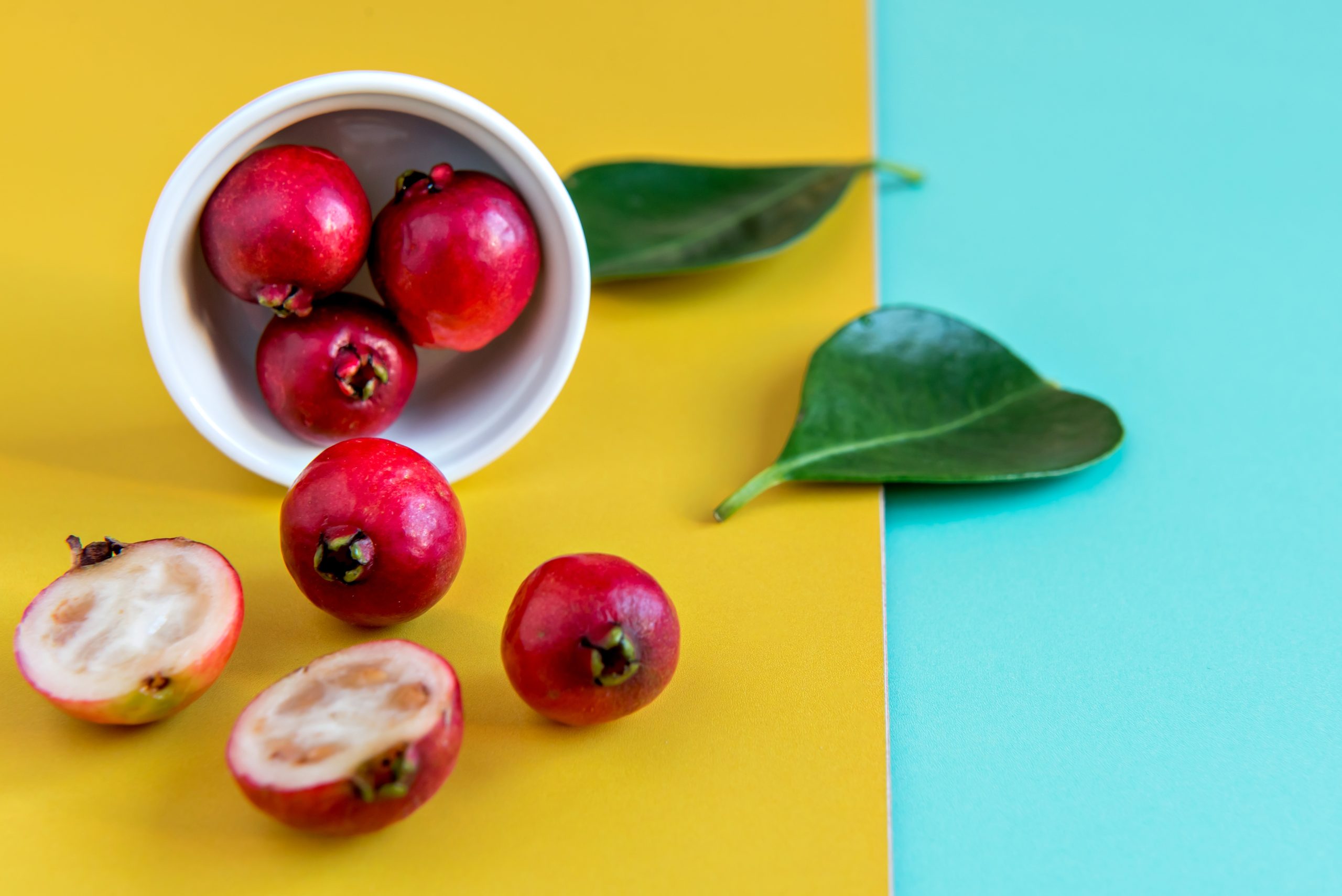Cherry guavas are a native fruit of South America that has become an invasive species in many parts of the world, including the United States. While it threatens local ecosystems, it is also a delicious and nutritious food source that should be embraced rather than eradicated.
Table of Contents
What is Cherry Guava?
The cherry guava (Psidium cattleyanum) is a small, round red fruit from the Myrtaceae family. It’s native to South America and is commonly grown in tropical and subtropical regions worldwide. It has other popular names, such as strawberry guava, Cattley guava, red cherry guava, and purple guava.
Unlike the common guava, the fruit is about the size of a cherry and resembles a small pomegranate, measuring about 1-2 inches in diameter. It has thin, edible skin that ranges in color from yellow to red and burgundy.
The flesh inside is juicy and can vary in color, such as white, yellow, or red, depending on the cultivar. For example, a sub-variety of yellow cherry guava (or lemon guava) is golden, sweeter than the strawberry guava, and has a flavor profile that combines passionfruit and lemon.
The center of the cherry guava contains many tiny, hard seeds that are edible but can be removed if desired.
The cherry guava plant is a small tree or shrub with glossy dark green leaves and small, white flowers that bloom in summer. For the fruit plant to germinate, it has to have a solid with a temperature between 70-85°F.
In terms of flavor, cherry guava has a unique taste that is often described as a combination of strawberry, pear, and plum, with spicy cinnamon-like notes.
What Does a Cherry Guava Taste Like?
When eaten raw, cherry guava has a sweet and slightly tart flavor with a texture similar to a plum or strawberry. The fruit’s flesh is juicy and has tiny edible seeds, which may be somewhat crunchy.
When cooked, cherry guava can have a more concentrated and slightly sweeter flavor.
Compared to other guava fruits, cherry guava has a more complex flavor profile, with notes of strawberry and cinnamon. It is generally considered one of the sweetest and most flavorful types of guava.
This unique taste makes it a popular ingredient in many cuisines worldwide. A few popular cherry guava dishes include jams, jellies, baked goods, and sauces for meat dishes.
How to Tell When Cherry Guava is Ripe
Color is the best indicator of when guava is ripe. The fruit should be deep red or pink like a cherry and will be firm to the touch but not hard. Another critical factor is that it will have a strong aroma.
If you’re harvesting it yourself, cherry guava should easily detach from the tree when gently pulled.
Tips for Selecting the Best Cherry Guava when shopping:
- Look for fruit that is plump, firm, and free of blemishes or bruises.
- Avoid fruits with greenish or pink hues, as they may not be fully ripe.
- A strong, sweet smell is a good indicator of ripe fruit.
If your cherry guava is not ripe, don’t worry! Rinse to remove any possible wax, place them at room temperature, and be patient.

Are Cherry Guavas Invasive?
Cherry guava is an invasive species that has spread to many other parts of the world, especially in Florida and Hawaii.
It can grow in many habitats and form dense thickets that prevent other plant species from growing. This translates to an incredible disruption of ecosystems, as it is challenging to get rid of and can cause other plants to die off.
However, plenty of efforts are being made to control the spreading, especially in Hawaiian forests.
Conservationists are using controlled burns of cherry guava trees to reduce their population without damaging other plant life. Removing fauna that increase the spread of cherry guava seeds, such as birds and feral pigs, has also allowed for better management of the species.
Can I Eat Raw Cherry Guava?
Yes, you can eat cherry guava raw; and in fact, many people enjoy it that way! Fresh cherry guava is safe to eat and can be consumed without any method of cooking or processing it.
When the fruit is ripe, it will be deep red and have a fragrant aroma. Just be sure to wash the fruit thoroughly before eating to remove any dirt or bacteria that may be present.
Cooking with Cherry Guava
It’s important to note that every part of the cherry guava fruit is edible.
Steps on preparing Cherry Guava:
- Wash the fruit thoroughly under running water to remove any dirt or debris.
- Cut off the calyx – the part right at the bottom of the guava.
- If desired, peel the skin off the fruit using a paring knife or vegetable peeler. The skin is edible, but some people prefer to remove it.
- Cut the fruit in half lengthwise.
Note: the seeds are also edible but can be gritty, so be careful when biting into the fruit’s flesh.
Traditional Cuisines that Feature Cherry Guava
Brazilian cuisine: In Brazil and other Portuguese-speaking countries, cherry guava is used to make a popular beverage called “goiabada,” a sweet paste made by cooking the fruit with sugar until it thickens. It’s also used in a popular dessert called “Romeu e Julieta,” which pairs slices of fresh cheese with goiabada.
Indian cuisine: In India, cherry guava is used to make chutneys, pickles, jams, and guava cheese.
Caribbean cuisine: In the Caribbean, cherry guava is used to make guava juice by blending cherry guava with water, sugar, and lime juice. Other popular uses include eating them raw or in fruit salads or using them for flavoring ice creams, cakes, and butter.
Some other popular dishes that feature cherry guava are:
- Cherry guava smoothie: Blend cherry guava with yogurt, honey, and ice for a refreshing and healthy drink.
- Cherry guava muffins: Add chopped cherry guava to your favorite muffin recipe for a tropical twist.
- Cherry guava salad: Combine cherry guava with mixed greens, feta cheese, and a citrus dressing for a colorful and flavorful salad.
How to Store Cherry Guava
The shelf life of cherry guava depends on the ripeness level. If the fruit isn’t ripe enough, it’s best to let them sit at room temperature for a couple of days until they turn red. Just make sure they’re not standing in full sun.
You can store guavas in the fridge for up to two days. Alternatively, you can cut them in pieces, place them in a ziplock bag, remove the air, and freeze them for up to 8 months.
Nutritional Benefits of Cherry Guava
Strawberry guava has many health benefits. It is rich in antioxidants, which prevent damage caused by free radicals, and also has plenty of potassium and vitamin C, which aid the body’s water regulation and strengthen the immune system.
Given that it has high levels of polyphenols, it has tremendous anti-aging effects while preventing cancer, heart disease, and diabetes.
Lastly, it’s believed to be good for mental health because it is known to increase serotonin levels.
Where to Purchase Cherry Guava
Typically, you’ll find most cherry guava fruits from trees if you plan to harvest them. But you can find them in some supermarkets or specialty stores if you want to buy them.
The best time to find cherry guava at a farmers’ market is during the fruit’s peak season, which varies depending on the region but is typically in the late summer or early fall.
You can also sometimes find it in canned or frozen form, which you can use in baking goods recipes.

